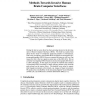Free Online Productivity Tools
i2Speak
i2Symbol
i2OCR
iTex2Img
iWeb2Print
iWeb2Shot
i2Type
iPdf2Split
iPdf2Merge
i2Bopomofo
i2Arabic
i2Style
i2Image
i2PDF
iLatex2Rtf
Sci2ools
NIPS
2004
2004
Methods Towards Invasive Human Brain Computer Interfaces
During the last ten years there has been growing interest in the development of Brain Computer Interfaces (BCIs). The field has mainly been driven by the needs of completely paralyzed patients to communicate. With a few exceptions, most human BCIs are based on extracranial electroencephalography (EEG). However, reported bit rates are still low. One reason for this is the low signal-to-noise ratio of the EEG [16]. We are currently investigating if BCIs based on electrocorticography (ECoG) are a viable alternative. In this paper we present the method and examples of intracranial EEG recordings of three epilepsy patients with electrode grids placed on the motor cortex. The patients were asked to repeatedly imagine movements of two kinds, e.g., tongue or finger movements. We analyze the classifiability of the data using Support Vector Machines (SVMs) [18,21] and Recursive Channel Elimination (RCE) [11].
| Added | 31 Oct 2010 |
| Updated | 31 Oct 2010 |
| Type | Conference |
| Year | 2004 |
| Where | NIPS |
| Authors | Thomas Navin Lal, Thilo Hinterberger, Guido Widman, Michael Schröder 0002, N. Jeremy Hill, Wolfgang Rosenstiel, Christian Erich Elger, Bernhard Schölkopf, Niels Birbaumer |
Comments (0)

